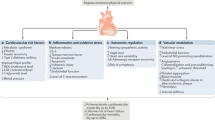Abstract
Endurance exercise training produces a series of cardiac adaptations including resting bradycardia, first and second degree atrioventricular block, increased intolerance to orthostatic stress, and enlargement of the left ventricular walls and of all cardiac chambers. Cardiac dimensions may be increased beyond the upper limits of normal and some endurance athletes demonstrate mild reductions in estimated left ventricular ejection fraction. Among athletes, such adaptations occur primarily in well trained endurance athletes. Clinicians should be aware of the cardiac changes accompanying endurance training to avoid unnecessary evaluation of physiological changes. On the other hand, the presence of conduction abnormalities or cardiac enlargement in low level or recreational athletes should prompt a search for pathological causes. Many of these findings were presented in the 1977 report on the marathon and have simply been better defined with subsequent studies.
Similar content being viewed by others
References
Gibbons LW, Cooper EH, Martin RP, et al. Medical examination and electrocardiographic analysis of elitedistance runners. Ann N Y Acad Sci 1977; 301: 283–96
Underwood RH, Schwade JL. Noninvasive analysis of cardiac function of elite distance runners: echocardiography, vector cardiography, and cardiac intervals. Ann N Y Acad Sci 1977; 301: 297–309
Estes NAM III, Link MS, Hamoud M, et al. Electrocardiographic variants and cardiac rhythm and conduction disturbances in the athlete. In: Thompson PD, editor. Exercise and sports cardiology. New York: McGraw-Hill, 2000: 211–32
Chapman J. Profound sinus bradycardia in the athletic heart syndrome. J Sports Med Phys Fitness 1981; 22: 294–8
Smith ML, Graitzer HM, Hudson DL, et al. Baroreflex function in endurance- and static exercise-trained men. J Appl Physiol 1988; 64 (2): 585–91
Huston TP, Puffer JC, Rorlney WM. The athletic heart syndrome. N Engl J Med 1985; 313 (1): 24–32
Thomas LR, Douglas PS. Echocardiographic findings in athletes. In: Thompson PD, editor. Exercise and sports cardiology. New York: McGraw-Hill, 2000: 43–70
Pelliccia A, Culasso F, Di Paolo FM, et al. Physiologic left ventricular cavity dilatation in elite athletes. Ann Intern Med 1999; 130 (1): 23–31
Pelliccia A, Maron BJ, Spataro A, et al. The upper limit of physiologic cardiac hypertrophy in highly trained elite athletes. N Engl J Med 1991; 324 (5): 295–301
Pelliccia A, Maron BJ, Di Paolo FM, et al. Prevalence and clinical significance of left atrial remodeling in compefitive athletes. J Am Coll Candiod 2005; 46 (4): 690.6
Nagashima J, Musha H, Takada H, et al. New upper limit of physiologic cardiac hypertrophy in Japanese participants in the 100-km ultramarathon. J Am Coll Cardiol 2003; 42 (9): 1617–23
Furlanello F, Bertoldi A, Dallago M, et al. Atrial fibrillation in elite athletes. J Cardiovasc Electrophysiol 1998; 9 (8 Suppl.): S63–8
Abergel E, Chatellier G, Hagege AA, et al. Serial left ventricular adaptations in world-class professional cyclists: implications for disease screening and follow-up. J Am Coll Cardiol 2004; 44 (1): 144–9
Acknowledgements
The author has indicated that he has no affiliation or financial interest in any organisation(s) that may have a direct interest in the subject matter of this article.
Author information
Authors and Affiliations
Corresponding author
Rights and permissions
About this article
Cite this article
Thompson, P.D. Cardiovascular Adaptations to Marathon Running. Sports Med 37, 444–447 (2007). https://doi.org/10.2165/00007256-200737040-00045
Published:
Issue Date:
DOI: https://doi.org/10.2165/00007256-200737040-00045




